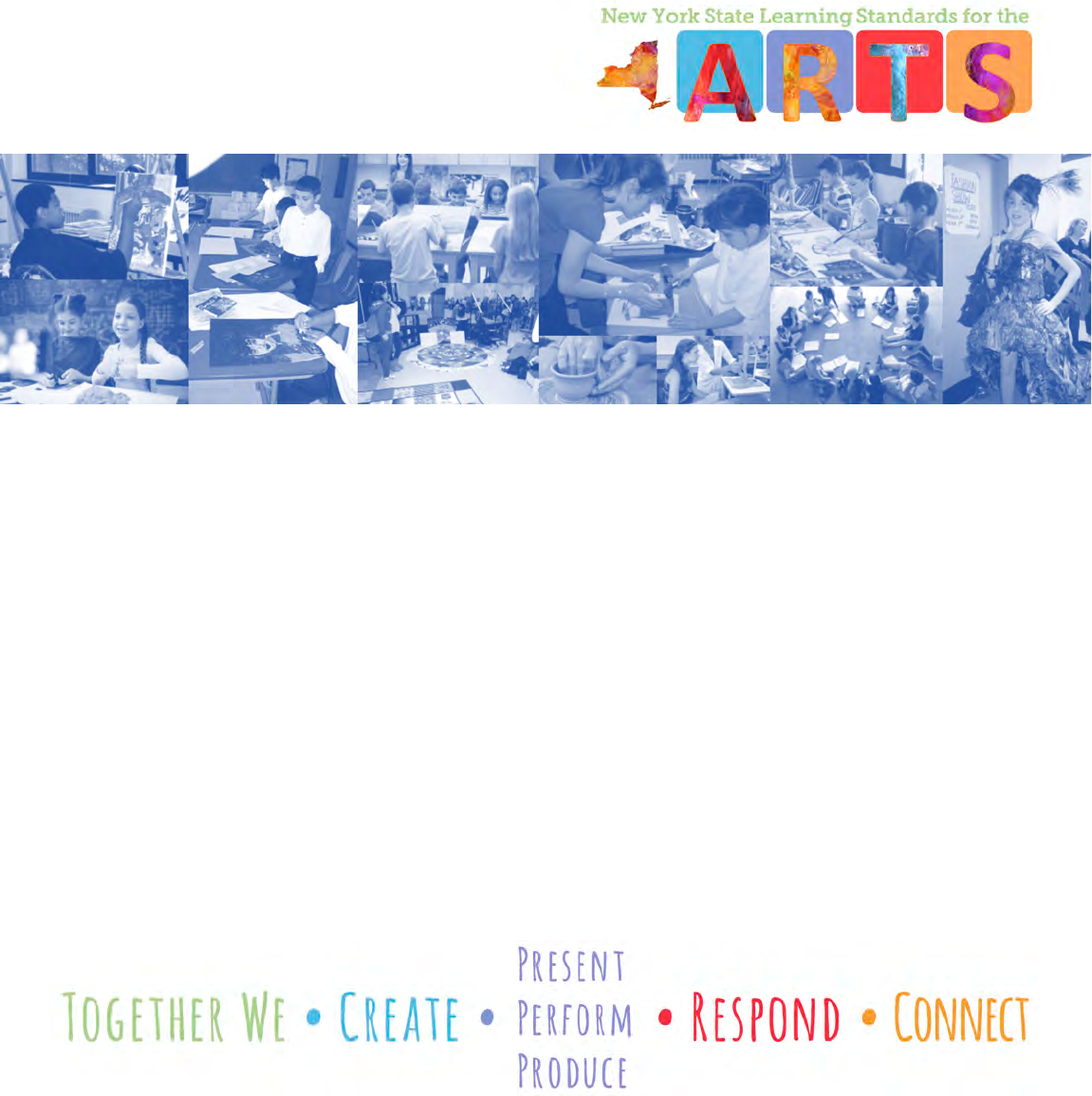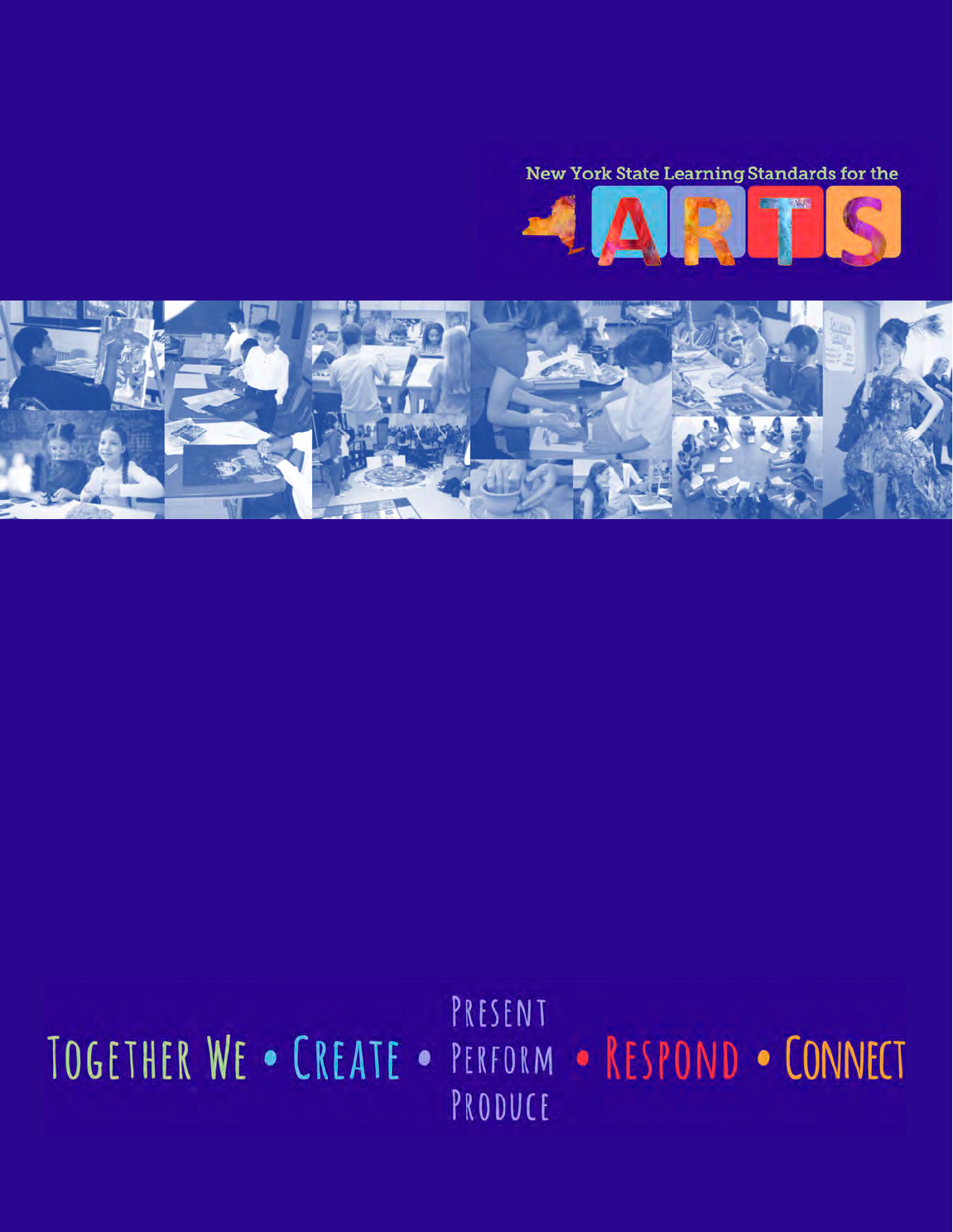
Visual Arts
Glossary

Visual Arts
Glossary

!
!
New York State Learning Standards for the Arts
VISUAL ARTS
GLOSSARY
of Discipline-Specific Terms & Concepts
Copyright 2017
The New York State Education Department

New York State Learning Standards for the Arts – Visual Arts Page 2 of 16
NOTES:
The letters “MA” in the next-to-right-hand column indicate that part or all of the definition is the same in the New
York State Visual Arts and Media Arts standards.
√ A checkmark in the far right-hand column indicates that a significant part or all of the definition is a New York
State addition to definitions published by the National Core Arts Standards (SEADAE, 2014). When only a small
part of a definition is added by NYS authors, that part is underlined.
NCAS definitions can be found at
http://www.nationalartsstandards.org/content/glossary.
Visual Arts
As defined by the National Art Education Association, includes the traditional fine arts,
such as drawing, painting, printmaking, photography, and sculpture; media arts,
including film, graphic communications, animation, and emerging technologies;
architectural, environmental, and industrial arts, such as urban, interior, product, and
landscape design; folk arts; and works of art, such as ceramics, fibers, jewelry, and works
in wood, paper, and other materials (Revised July 2012).
Definitions
Shared
with Media
Arts
NYS
additions
to NCAS
A
Aesthetic
Specific artistic awareness, or a deep appreciation of the meaning of an artistic
experience through intellectual, emotional, and sensual responses to a work of art.
MA
√
In some cases, it is a set of principles underlying and guiding the work of a
particular artist or artistic movement.
Aesthetics
The philosophical inquiry into the nature of what makes a work of art a “work of
art,” and not just an object; our response to the work, and the resulting
examination of our values concerning art.
MA
√
Other aesthetic inquiries include questions like who is the artist? or when or
under what circumstances is a work art? Aesthetics can change over time, in
response to context and culture.
Analyze
Examine methodically and in detail the constitution or structure of something,
MA
√
typically for purposes of explanation, interpretation, or deeper understanding.
Appropriation
The intentional borrowing, copying, and altering of pre-existing images and
MA
objects.
!

New York State Learning Standards for the Arts – Visual Arts Page 3 of 16
Shared
NYS
with Media
additions
Arts
to NCAS
Art
In everyday discussions and in the history of aesthetics, multiple (and sometimes
contradictory) definitions of art have been proposed. In a classic article, “The Role
of Theory in Aesthetics,” Morris Weitz (1956) recommended
differentiating between classificatory (classifying) and honorific (honoring)
definitions of art.
In the New York State Learning Standards for the Arts, the word “art” is used in
the classificatory sense to mean “an artifact or action that has been put forward by
an artist or other person as something to be experienced, interpreted, and
appreciated.”
An important component of a quality visual arts education is for students to
engage in discussions about honorific definitions of art: identifying the wide range
of significant features in art-making approaches, analyzing why artists follow or
break with traditions, and discussing their own understandings of the
characteristics of “good art.”
Art criticism
The combined act (not always in this order) of carefully observing; describing;
analyzing form, structure and/or application of media; and interpreting meaning
in a work of art based on what has been perceived. Some theorists add evaluation
or judgment as a final step. Others include creating connections with other works
and/or integrating context.
MA
√
Art history
Discussion, research, and writing about artists, their work, influences on their lives
and work, and writings about and by that artist. Also, the published results of
scholarship that seeks to explain relationships between artworks and art
movements by sorting art into categories and organized systems (e.g. chronological
order, styles, genres, “isms,” etc.).
√
Art production
The direct experience and process of creating art by using materials, techniques,
perceptual skills, and imagination to explore, set down, and communicate
observations, ideas and feelings about the tangible and intangible worlds around
us. Through the creative process of developing and manipulating images, students
gain an intimate familiarity with the rich synthesis of motives that inspire the
√
making of art.
Artist statement
Information about context, explanations of process, descriptions of learning,
related stories, reflections, or other details in a written or spoken format shared by
the artist to extend and deepen understanding of his or her artwork; an artist
statement can be didactic, descriptive, or reflective in nature.
!

New York State Learning Standards for the Arts – Visual Arts Page 4 of 16
Shared
with Media
Arts
NYS
additions
to NCAS
Artistic investigations
In making art, forms of inquiry and exploration. Through artistic investigation,
artists go beyond illustrating pre-existing ideas or following directions, and
generate fresh insights – new ways of seeing and knowing.
Artistic processes
An overarching term that includes artmaking approaches, creative process
strategies, and the use of tools, techniques, and media (bold words – see
separate definitions).
√
Artistic work
Artifacts or actions that have been put forward by an artist or other person as
something to be experienced, interpreted, and appreciated.
MA
√
Artmaking approaches
Diverse strategies and procedures by which artists initiate and pursue making a
work of art.
Artwork
Artifact or product that has been put forward by an artist or other person as
something to be experienced, interpreted, and appreciated.
MA
√
B
Brainstorm
Technique for the initial production of ideas or ways of solving a problem by which
ideas are spontaneously contributed without critical comment or judgment.
C
Categorize
Arrange or group things in categories according to shared qualities or
characteristics.
√
Characteristic(s)
Attribute, feature, property, or essential quality.
Collaborate, Collaboration
Working together to formulate and solve creative problems.
MA
Collaboratively
Joining with others in attentive participation in an activity of imagining, exploring,
or making.
MA
!

New York State Learning Standards for the Arts – Visual Arts Page 5 of 16
Composition
A whole made up of multiple parts arranged in such a way that the relationships
between the parts work together to create a particular effect or meaning.
Concepts
Ideas, thoughts, schemata; art arising out of conceptual experimentation;
emphasizes making meaning through ideas rather than through materiality or
form.
Conservation
The act of conserving; prevention of decay, waste, or loss; preservation; or the
preservation and restoration of works of art.
Construct
Build, make, or create something (such as an object, story, or theory) by using
strategies, rules, or instructions to organize materials, ideas, words, etc.
Constructed environment
Human-made or human-modified spaces and places; art and design-related
disciplines such as architecture, urban planning, interior design, game design,
virtual environment, and landscape design and shape the places in which people
live, work, and play.
Contemporary artistic practice
Processes, techniques, media, procedures, behaviors, actions, and conceptual
approaches by which an artist or designer makes work, using methods that, though
possibly based on traditional practices, reflect changing contextual, conceptual,
aesthetic, material, and technical possibilities. Examples include artwork made
with appropriated images or materials; social practice artworks that involve the
audience; performance art, new media works, installations; and artistic
interventions in public spaces.
Context
Interrelated influences surrounding the creation and experience of an artwork,
including the artist, audience, time, culture, presentation, and physical or virtual
location of the production and reception of the work. Often divided into the larger
categories of personal, social, historical, and cultural kinds of context.
Convention
An established, common, or predictable rule, method, or practice.
Copyright
Form of protection grounded in the US Constitution and granted by law for
original works of authorship fixed in a tangible medium of expression, covering
both published and unpublished works.
Craftsmanship
Workmanship, artistry, and mastery of technique.
Shared
NYS
with Media
additions
Arts
to NCAS
MA
√
√
√
√
MA
√
MA
√
MA
√
!

New York State Learning Standards for the Arts – Visual Arts Page 6 of 16
Shared
NYS
with Media
additions
Arts
to NCAS
Create, Creativity (n.)
Conceive and develop rich, original ideas; discover unexpected connections; and
invent or make new things.
Creative Commons
Copyright license templates that provide a simple, standardized way to give the
MA
public permission to share and use creative work on conditions of the maker’s
choice.
Creative economy
A creative economy is based on people’s use of their creative imagination to
increase an idea’s value. In a creative economy, value is based on novel,
imaginative qualities rather than on the traditional resources of land, labor, and
MA
√
capital. Some observers take the view that creativity is the defining characteristic
of developed 21st century economies, just as manufacturing typified 19th and early
20th century economies.
Creative process
There are various models of the creative process that contain stages of work
phases, such as inspiration, clarification, distillation, perspiration, evaluation, and
MA
√
incubation. During a particular piece of creative work, each phase might be
experienced many times, in no definite order or duration of time.
Criteria (plural), Criterion (singular)
The particular parameters (content, context, desired effect, form, structure,
MA
√
duration, medium, etc.) used to define and/or evaluate an assignment, task, or
work.
• Contemporary criteria—Principles by which a work of art or design is
understood and evaluated in contemporary contexts that include, for
example, judgment based not necessarily on originality, but rather on how
the work is re-contextualized to create new meanings.
• Established criteria—Identified principles that direct attention to
significant aspects of various types of artwork in order to provide guidelines
for evaluating the work; may be commonly accepted principles developed
by artists, curators, historians, critics, educators, and others, or principles
developed by an individual or group that pertain to a specific work of art or
design.
• Personal criteria—Principles for evaluating art and design, based on
individual preferences.
• Relevant criteria—Principles that apply to making, revising,
understanding, and evaluating a particular work of art or design that are
generated by identifying the significant characteristics of a work.
!

New York State Learning Standards for the Arts – Visual Arts Page 7 of 16
Shared
with Media
Arts
NYS
additions
to NCAS
Critique
Individual or collective reflective process by which artists or designers experience,
analyze, and evaluate a work of art or design.
MA
Cultural contexts
Ideas, beliefs, values, norms, customs, traits, practices, and characteristics shared
by individuals within a group that form the circumstances surrounding the
creation, presentation, preservation, and response to art.
Cultural traditions
Pattern of practices and beliefs within a societal group.
Cultural, Culture
Pertaining to values and beliefs of a particular group of people, from a specific
place or time, expressed through characteristics such as tradition, social structure,
religion, art, and food.
MA
Curate
Collect, sort, and organize objects, artwork, and artifacts; preserve and maintain
historical records and catalogue exhibits.
MA
Curator
Person responsible for acquiring, caring for, and exhibiting objects, artworks, and
artifacts.
D
Describe
Give a factual account, usually in words, of someone or something, including all of
the relevant characteristics, qualities, or events.
√
Design
Application of creativity to planning the optimal solution to a given problem, and
communication of that plan to others.
Design thinking
A formal, cognitive methodology for practical, innovative resolution of problems
and creation of solutions, with the intent of an improved future result. Design
thinking specifically starts with empathizing with and gathering information on
the needs of all constituents involved, not just a specific party; goal setting is
geared for a better future situation rather than resolving a discrete problem
independent of reference to the current and future environment. A popular version
of the design thinking process has seven stages: define, research, ideate,
prototype, choose, implement, and learn.
Within these steps, problems can be framed, the right questions can be asked,
more ideas can be created, and the best answers can be chosen. The steps aren't
linear; they can occur simultaneously and be repeated. cont’d
MA
√
!

New York State Learning Standards for the Arts – Visual Arts Page 8 of 16
Shared
with Media
Arts
NYS
additions
to NCAS
By considering both present and future conditions and parameters of the problem,
alternative solutions may be explored simultaneously. Learning happens
throughout the process, from the early research phase to the final presentation.
Design thinking has been adapted for business purposes as a method of developing
divergent and innovative solutions.
MA
√
Digital, Digital format
Anything in electronic form, including photos, images, video, audio files, or
artwork, created or presented through electronic means; a gallery of artwork
viewed electronically through any device.
MA
√
Document
Record in written, photographic, or other form.
E
Edit, Editing
To change a work of art to move it closer to a resolved state, ready for viewing or
publication. Though usually associated with shortening and correcting, it can also
include rearranging, adding, revising, refining, clarifying, etc.
MA
√
Elements (of art) and Principles (of design)
Elements are visual forms used by artists in the creation of an artwork, such
as line, color, shape, mass, size, etc. Principles describe structural
relationships between the forms, such as balance, contrast, pattern, etc.
Many classrooms feature a commercialized formulation of elements and
principles, but, in truth, there is no consensus in the field about a uniform set of
elements and principles. There are other relationships that are commonly found in
works of art that are neither elements nor principles, such as time, flavor, sound,
site-specificity, juxtaposition, re-contextualization, hybridization, etc. These
limitations have led to the contemporary use of the more inclusive phrase form
and structure.
MA
√
Ethics
Moral guidelines and philosophical principles for determining appropriate
behavior within arts environments.
MA
√
Evaluate
Judge or determine the significance, worth, or quality of something.
MA
√
Exhibition narrative
Written description of an exhibition intended to educate viewers about its purpose.
!

New York State Learning Standards for the Arts – Visual Arts Page 9 of 16
Expressive properties
Moods, feelings, or ideas evoked or suggested through the attributes, features, or
qualities of an image or work of art.
F
Fair Use
Limitation in copyright law that sets out factors to be considered in determining
whether or not a particular use of one’s work is “fair,” such as the purpose and
character of the use, the amount of the work used, and whether the use will affect
the market for the work.
Form
The visible shape, structure, or configuration of something.
Form and structure
Terms drawn from traditional, modern, and contemporary sources that identify
the range of attributes that can be used to describe works of art and design to aid
students in experiencing and perceiving the qualities of artwork, enabling them to
create their own work and to appreciate and interpret the work of others.
Generally, form refers to the overall configuration and mode of the work. Structure
refers to the organization of interrelated elements in works of art.
Form and structure might include traditional principles of design, as well as
contemporary systems of organization.
Formal and conceptual vocabularies
Terms, methods, concepts, or strategies used to experience, describe, analyze,
plan, and make works of art and design drawn from traditional, modern,
contemporary, and continually emerging sources in diverse cultures.
Function
The function of an object refers to its use and how it works or operates in a proper
or particular way.
G
Generate
To bring into existence, cause to be, produce; to create and distribute with
profusion.
Generative methods
Various inventive techniques for creating new ideas and models, such as
brainstorming, play, open exploration, experimentation, inverting assumptions,
rule-bending, etc.
Shared
NYS
with Media
additions
Arts
to NCAS
MA
MA
MA
√
√
√
MA
√
!

New York State Learning Standards for the Arts – Visual Arts Page 10 of 16
Shared
with Media
Arts
NYS
additions
to NCAS
Genre
Category of art or design identified by similarities in form, subject matter, content,
or technique.
MA
H
Hybridization
The practice of combining two or more existing media forms to create new and
original forms, such as multi-media sculptural installations. Used in particular
when referencing artworks or art experiences that utilize some form of electronic
imagery and/or sound.
MA
√
I
Identity
The conceptions, qualities, beliefs, and experiences that make up a person or a
group.
√
Image
Visual representation of something.
Imagery
See Visual imagery.
√
Imaginative play
Experimentation by children that defines identities and points of view by
developing skills in conceiving, planning, making art, and communicating.
Innovate
The act or process of introducing new ideas, devices, or methods; often also viewed
as the application of better solutions that meet new requirements, unarticulated
needs, or existing market needs.
MA
√
Innovation
New changes in existent processes or products that improve or expand
functionality, ease of use, new applications, etc.
MA
√
Innovative thinking
Imagining or conceiving something new and unexpected, including fresh ideas and
ways of looking at things and new approaches to old problems, as well as
formulating new problems.
MA
Installation
(Usually) large-scale mixed media construction, sometimes interactive, and often
designed for a specific place and/or temporary period of time; designed to
transform the viewer’s experience and perception of the space.
√
!

New York State Learning Standards for the Arts – Visual Arts Page 11 of 16
Shared
NYS
with Media
additions
Arts
to NCAS
Interactive art
Art that requires the viewer to participate in the work in some way, beyond
viewing. Interactive art breaks down traditional boundaries between the work of
art and the viewer, and frequently raises the aesthetic question, “Who is the
artist?”
√
Actual participation in a work of art creates a different aesthetic experience than
just viewing it alone, and blurs the boundaries between visual art and theatre.
Artworks that require participation also ask the viewer(s) to consider, “Who is the
artist?”, “When and where is the art?”, and “Is the viewer’s participation essential
to making it art?”
Interpret
Draw inferences about, discern or extract meaning, purpose, and/or subject of
investigation, based on visual evidence gathered through observation and analysis,
and examination of context.
MA
√
In some senses can be construed to mean how one artist “interprets” the work of
another artist, by remaking it and/or referencing it in a new or different context,
resulting in another work of art.
Interpretation
The resulting meaning or explanation (textual or visual) derived from the act of
MA
√
interpreting.
Invent
Produce (something, such as a useful device or process) for the first time through
MA
√
the use of the imagination or of ingenious thinking and experiment.
Inventive
Quality of being potentially useful yet imaginative, ingenious, and/or
MA
√
experimental.
Invention
MA
√
Something invented.
Investigate
√
Carry out a systematic or formal inquiry.
J
Justify
To provide a good reason for; to prove or show something to be just, right, or
√
reasonable.
!

New York State Learning Standards for the Arts – Visual Arts Page 12 of 16
Shared
with Media
Arts
NYS
additions
to NCAS
Juxtaposition
The putting together of two or more things that are normally not found together.
In artwork, this often prompts the viewer to make new associations among objects
or to think about connections her or she hasn’t considered before.
MA
√
K
L
M
Material culture
Human-constructed or human-mediated objects, forms, or expressions that extend
to other senses and study beyond the traditional art historical focus on the
exemplary to the study of common objects, ordinary spaces, and everyday rituals.
MA
Materials
Substances out of which art is made or composed, ranging from the traditional to
“non-art” material and virtual, cybernetic, and simulated materials.
Meaning, Meaningful
Purpose and/or significance expressed or indicated through a work of art.
MA
√
Media, Medium
Mode(s) of artistic expression or communication; material or other resources used
for creating art.
Media art(s), Media artwork
Media art is understood to apply to all forms of time-related art works which are
created by recording sound and/or visual images. Media artwork usually depends
on a technological component to function. It includes both fine art and
commercially-oriented works presented via film, television, radio, audio, video, the
internet, interactive and mobile technologies, transmedia storytelling, and
satellite.
Forms that are shared with contemporary visual arts/fine arts include kinetic
sculpture, information art, organic and algorithmic art, interactive art, multimedia
installations, etc. Other more commercially-oriented forms include news
reporting, documentaries, advertisements, music videos, animation, machinima,
video games and game design, and/or a combination of any of these. Media art
forms are constantly evolving in response to technological innovations.
MA
√
Media literacy
A series of communication competencies, including the ability to access, analyze,
evaluate, and communicate information in a variety of forms, including print and
non-print messages.
MA
√
!

New York State Learning Standards for the Arts – Visual Arts Page 13 of 16
Shared
with Media
Arts
NYS
additions
to NCAS
Mediate
A medium or media is so-named because it “mediates” (affects, changes) our
thinking in some way (Eisner). That is, by taking our thoughts beyond simply
thinking them, and exploring them through a particular medium outside of our
minds, that medium changes or acts upon our thinking in a transactional,
reciprocal way.
√
Metaphor
A figure of speech that refers to one thing by mentioning another thing. It may
provide clarity or identify hidden similarities between two ideas. A metaphor
allows us to use what we know about our physical and social experience to provide
understanding of countless other subjects by matching similar gestalts (organizing
features, underlying patterns) of story, action, feeling, being, etc. In this sense,
artworks can act as visual metaphors for different human experiences.
√
Multimedia
The integration of multiple forms of media.
MA
√
N
O
Open source
Computer software for which the copyright holder freely provides the right to use,
study, change, and distribute the software to anyone for any purpose.
MA
P
Play
Spontaneous, engaged activity through which children learn to experience,
experiment, discover, and create.
Popular culture
Cultural activities, beliefs, customs, art, and/or products aimed at the common
tastes of a broad cross section of people.
MA
√
Portfolio
Actual or virtual collection of artworks and documentation demonstrating art and
design knowledge and skills, organized to reflect an individual’s creative growth
and artistic literacy.
Preservation
Activity of protecting, saving, and caring for objects, artifacts, and artwork through
a variety of means.
Preserve
Protect, save, and care for objects, artifacts, and artwork.
!

New York State Learning Standards for the Arts – Visual Arts Page 14 of 16
Shared
with Media
Arts
NYS
additions
to NCAS
Q
R
Reflect
Think deeply, carefully, or introspectively about an object, place, process, idea, or
experience.
√
Represent
Symbolize, express, designate, stand for, or denote, as a word or symbol represents
an idea or object.
√
Repurpose
Adapt for use in a different purpose than originally found serving or intended.
√
Responsible use
When using technology, application of a normal standard of academic integrity,
polite conduct and respect for the rights and privacy of others; includes use of anti-
virus software and prevention of the spread of viruses and malware. Expectation to
act responsibly and abide by all state and federal laws.
MA
√
S
Social media
Digital network-mediated digital technologies that allow the creating and sharing
of information, ideas, career interests, and other forms of expression via virtual
communities.
MA
√
Structure
An arrangement and organization of interrelated elements in a material object or
system. Structure in artwork might include traditional principles of design, as well
as contemporary systems of organization.
√
Style
Recognizable characteristics of art or design that are found consistently in
historical periods, cultural traditions, schools of art, or works by an individual
artist.
T
Technical, Technique(s)
Pertaining to specialized methods and procedures used with tools and materials to
effect a desired result.
MA
√
Technologies
Tools, techniques, crafts, systems, and methods to shape, adapt, and preserve
artwork, artifacts, objects, and natural and human-made environments.
!

V
New York State Learning Standards for the Arts – Visual Arts Page 15 of 16
Text
That form through which information can be gathered, expanding beyond the
traditional notion of written language to encompass visual representations, such as
paintings, sculpture, diagrams, graphics, films, and maps.
Theme
A main idea or an underlying meaning of a work or collection of works.
Traditional and contemporary practices
Tradition refers to a belief, habit, or behavior passed down within a group or
society with origins in the past. Many traditional practices have symbolic meaning
or special significance to an individual or group.
Contemporary practices break with tradition and incorporate innovative
thinking and unexpected results.
It is important for students to learn about, explore, and experience both traditional
and contemporary practices in the art classroom.
U
Venue
Place or setting for an art exhibition, either a physical space or a virtual
environment.
Virtual environment
A computer-generated, three-dimensional representation of a setting in which
the user of the technology perceives themselves to be, and within which
interaction takes place; also called virtual landscape, virtual space, virtual world.
Visual Art(s)
As defined by the National Art Education Association, includes the traditional fine
arts, such as drawing, painting, printmaking, photography, and sculpture; media
arts, including film, graphic communications, animation, and emerging
technologies; architectural, environmental, and industrial arts, such as urban,
interior, product, and landscape design; folk arts; and works of art, such as
ceramics, fibers, jewelry, and works in wood, paper, and other materials (Revised
July 2012).
Visual culture
The aspect of culture expressed in visual images, especially mass media,
advertising, and commercial images. While the image remains a focal point in
visual culture studies, it is the relationships between images and consumers that
are evaluated for their cultural significance, not just the images in and of
themselves.
Shared
NYS
with Media
additions
Arts
to NCAS
MA
√
MA
√
MA
MA
√
MA
MA
√
!

X
New York State Learning Standards for the Arts – Visual Arts Page 16 of 16
Shared
NYS
with Media
additions
Arts
to NCAS
Visual components
Properties of an image that can be perceived.
Visual image. Visual imagery
Group of images; images in general.
Visual organization approaches and strategies
Graphic design strategies, such as hierarchy, consistency, grids, spacing, scale,
weight, proximity, alignment, and typography choice, used to create focus and
clarity in a work.
Visual plan
Drawing, picture, diagram, or model of the layout of an art exhibit in which
individual works of art and artifacts are presented along with interpretive
materials within a given space or venue.
Visual presentation
√
A presentation that communicates information visually to others.
W
Y
Z
!
